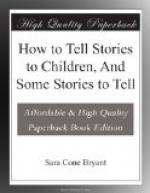Having this touchstone in mind for general selection, we can now pass to the matter of specific choices for different ages of children. No one can speak with absolute conviction in this matter, so greatly do the taste and capacity of children of the same age vary. Any approach to an exact classification of juvenile books according to their suitability for different ages will be found impossible. The same book in the hands of a skilful narrator may be made to afford delight to children both of five and ten. The following are merely the inferences drawn from my own experience. They must be modified by each teacher according to the conditions of her small audience. In general, I believe it to be wise to plan the choice of stories much as indicated in the table given on page 64.
At a later stage, varying with the standard of capacity of different classes, we find the temper of mind which asks continually, “Is that true?” To meet this demand, one draws on historical and scientific anecdote, and on reminiscence. But the demand is never so exclusive that fictitious narrative need be cast aside. All that is necessary is to state frankly that the story you are telling is “just a story,” or—if it be the case—that it is “part true and part story.”
At all stages I would urge the telling of Bible stories, as far as is allowed by the special circumstances of the school. These are stories from a source unsurpassed in our literature for purity of style and loftiness of subject. More especially I urge the telling of the Christ-story, in such parts as seem likely to be within the grasp of the several classes. In all Bible stories it is well to keep as near as possible to the original unimprovable text.[1] Some amplification can be made, but no excessive modernising or simplifying is excusable in face of the austere grace and majestic simplicity of the original. Such adaptation as helps to cut the long narrative into separate units, making each an intelligible story, I have ventured to illustrate according to my own personal taste, in two stories given in Chapter VI. The object of the usual modernising or enlarging of the text may be far better attained for the child listener by infusing into the text as it stands a strong realising sense of its meaning and vitality, letting it give its own message through a fit medium of expression.
[Footnote 1: Stories from the Old Testament, by S. Platt, retells the Old Testament story as nearly as possible in the actual words of the Authorised Version.]
The stories given in pages 133 to 246 are grouped as illustrations of the types suitable for different stages. They are, however, very often interchangeable; and many stories can be told successfully to all classes. A vitally good story is little limited in its appeal. It is, nevertheless, a help to have certain plain results of experience as a basis for choice; that which is given is intended only for such a basis, not in the least as a final list.




